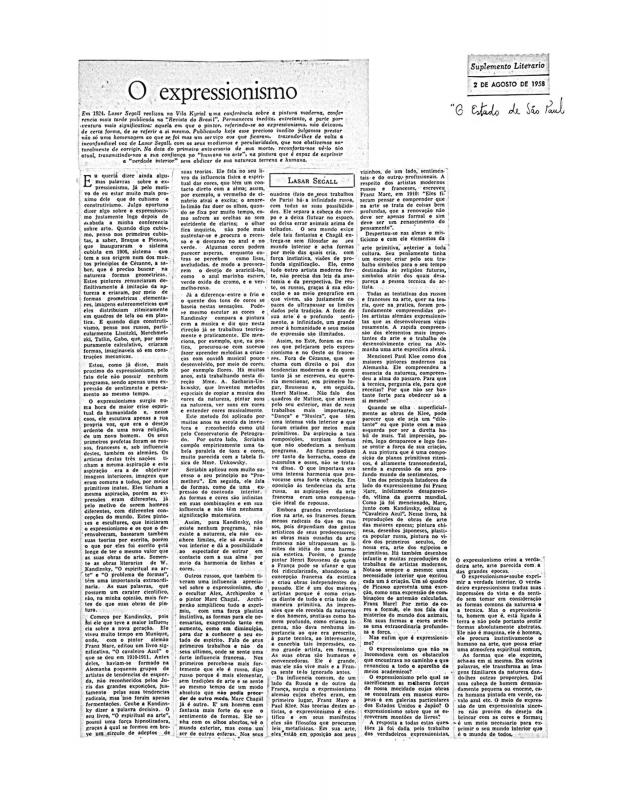This newspaper article—that reports on an earlier interview with Lasar Segall—announces the founding of two art organizations: SPAM (Sociedade Pró-Arte Moderna) and CAM (Club dos Artistas Modernos), although the text of the article refers specifically to the former. As explained by Segall, SPAM’s goal was to publicize the needs of the art world which, in those days, was in a “precarious condition.” The painter also mentions the organization’s educational strategy designed to “clarify contemporary issues in the field of art.”
Lasar Segall (1891–1957) was born in Vilnius, Lithuania, where his family was part of the Jewish community. He enrolled in the School of Applied Arts in Berlin and, in the early years of the century, spent time at the Academy of Fine Arts. In 1912 he travelled to Brazil, where his brothers were already living. The Centro de Ciências e Artes de Campinas (São Paulo) bought one of his paintings: Cabeça de menina russa (1908). He returned to Europe during the First World War. Joining forces with a group of German painters (such as Otto Dix) he co-founded the Dresdner Sezession – Gruppe 1919. After an exhibition of Russian art in Hanover in 1921 he established a relationship with Kandinsky. In 1923 he returned to Brazil. He painted a mural at the Pavilhão de Arte Moderna, a meeting place for artists and intellectuals at the home of the great promoter of the Semana de Arte Moderna of 1922, Mrs. Olivia Guedes Penteado. The mural was reviewed by Mário de Andrade, who identified his “Brazilian phase” (1924–28). Segall took part in SPAM’s Primeira Exposição de Arte Moderno and the Spamolândia project in 1934. Three of his paintings and seven prints were featured in the Entartete Kunst Ausstellungsführer [Exhibition of Degenerate Art] organized by the Nazis in Munich in 1937 to discredit modern art. In the 1940s Segall traveled, painted stage sets, and illustrated books and magazines. His major work, Navio de emigrantes (1939–41), was highly praised by George Grosz.
For more information on this painter’s essays about art in Brazil, see the lecture “O expressionismo” [doc. no. 783352]; the essay “Existe uma arte judaica?” [doc. no. 783319]; and the brief text “O manifesto da SPAM” [doc. no. 783455].
The noted critic, poet, musicologist, and cultural promoter Mário de Andrade (1893–1945) closely followed Segall’s career in Brazil, writing several articles outlining what he described as the painter’s “visual art biography” during the time he lived in Brazil [doc. no. 783393]. He also introduced the album of drawings of the work Mangue produced by Segall [doc. no. 1111411].
There was also a great deal of interest in the 82 pages devoted to him in the “Revista Acadêmica: número de homenagem a Lasar Segall” [doc. no. 1110322] and a critical essay by Abilio Álvaro Miller, “Um pintor de almas” [doc. no. 1084988].







